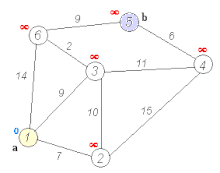 Dijkstra's algorithm to find the shortest path between a and b. It picks the unvisited vertex with the lowest distance, calculates the distance through it to each unvisited neighbor, and updates the neighbor's distance if smaller. Mark visited (set to red) when done with neighbors. | |
| Class | Search algorithm Greedy algorithm Dynamic programming[1] |
|---|---|
| Data structure | Graph Usually used with priority queue or heap for optimization[2][3] |
| Worst-case performance | [3] |
Dijkstra's algorithm (/ˈdaɪkstrəz/ DYKE-strəz) is an algorithm for finding the shortest paths between nodes in a weighted graph, which may represent, for example, road networks. It was conceived by computer scientist Edsger W. Dijkstra in 1956 and published three years later.[4][5][6]
Dijkstra's algorithm finds the shortest path from a given source node to every other node.[7]: 196–206 It can also be used to find the shortest path to a specific destination node, by terminating the algorithm once the shortest path to the destination node is known. For example, if the nodes of the graph represent cities, and the costs of edges represent the average distances between pairs of cities connected by a direct road, then Dijkstra's algorithm can be used to find the shortest route between one city and all other cities. A common application of shortest path algorithms is network routing protocols, most notably IS-IS (Intermediate System to Intermediate System) and OSPF (Open Shortest Path First). It is also employed as a subroutine in other algorithms such as Johnson's algorithm.
The algorithm uses a min-priority queue data structure for selecting the shortest paths known so far. Before more advanced priority queue structures were discovered, Dijkstra's original algorithm ran in time, where is the number of nodes.[8] The idea of this algorithm is also given in Leyzorek et al. 1957. Fredman & Tarjan 1984 proposed using a Fibonacci heap priority queue to optimize the running time complexity to . This is asymptotically the fastest known single-source shortest-path algorithm for arbitrary directed graphs with unbounded non-negative weights. However, specialized cases (such as bounded/integer weights, directed acyclic graphs etc.) can indeed be improved further, as detailed in Specialized variants. Additionally, if preprocessing is allowed, algorithms such as contraction hierarchies can be up to seven orders of magnitude faster.
Dijkstra's algorithm is commonly used on graphs where the edge weights are positive integers or real numbers. It can be generalized to any graph where the edge weights are partially ordered, provided the subsequent labels (a subsequent label is produced when traversing an edge) are monotonically non-decreasing.[9][10]
In many fields, particularly artificial intelligence, Dijkstra's algorithm or a variant of it is known as uniform cost search and formulated as an instance of the more general idea of best-first search.[11]
- ^ Controversial, see Moshe Sniedovich (2006). "Dijkstra's algorithm revisited: the dynamic programming connexion". Control and Cybernetics. 35: 599–620. and below part.
- ^ Cite error: The named reference
Introwas invoked but never defined (see the help page). - ^ a b Fredman & Tarjan 1987
- ^ Richards, Hamilton. "Edsger Wybe Dijkstra". A.M. Turing Award. Association for Computing Machinery. Retrieved 16 October 2017.
At the Mathematical Centre a major project was building the ARMAC computer. For its official inauguration in 1956, Dijkstra devised a program to solve a problem interesting to a nontechnical audience: Given a network of roads connecting cities, what is the shortest route between two designated cities?
- ^ Frana, Phil (August 2010). "An Interview with Edsger W. Dijkstra". Communications of the ACM. 53 (8): 41–47. doi:10.1145/1787234.1787249. S2CID 27009702.
- ^ Dijkstra, E. W. (1959). "A note on two problems in connexion with graphs". Numerische Mathematik. 1: 269–271. CiteSeerX 10.1.1.165.7577. doi:10.1007/BF01386390. S2CID 123284777.
- ^ Cite error: The named reference
mehlhornwas invoked but never defined (see the help page). - ^ Schrijver, Alexander (2012). "On the history of the shortest path problem" (PDF). Documenta Mathematica. Documenta Mathematica Series: 155–167. doi:10.4171/dms/6/19. ISBN 978-3-936609-58-5.
- ^ Szcześniak, Ireneusz; Jajszczyk, Andrzej; Woźna-Szcześniak, Bożena (2019). "Generic Dijkstra for optical networks". Journal of Optical Communications and Networking. 11 (11): 568–577. arXiv:1810.04481. doi:10.1364/JOCN.11.000568. S2CID 52958911.
- ^ Szcześniak, Ireneusz; Woźna-Szcześniak, Bożena (2023), "Generic Dijkstra: Correctness and tractability", NOMS 2023-2023 IEEE/IFIP Network Operations and Management Symposium, pp. 1–7, arXiv:2204.13547, doi:10.1109/NOMS56928.2023.10154322, ISBN 978-1-6654-7716-1, S2CID 248427020
- ^ Cite error: The named reference
felnerwas invoked but never defined (see the help page).


